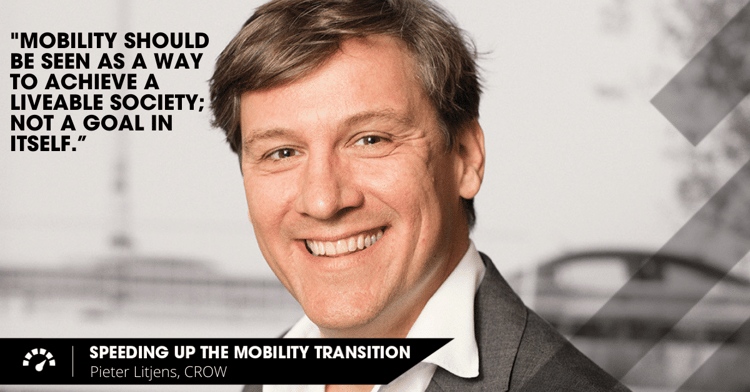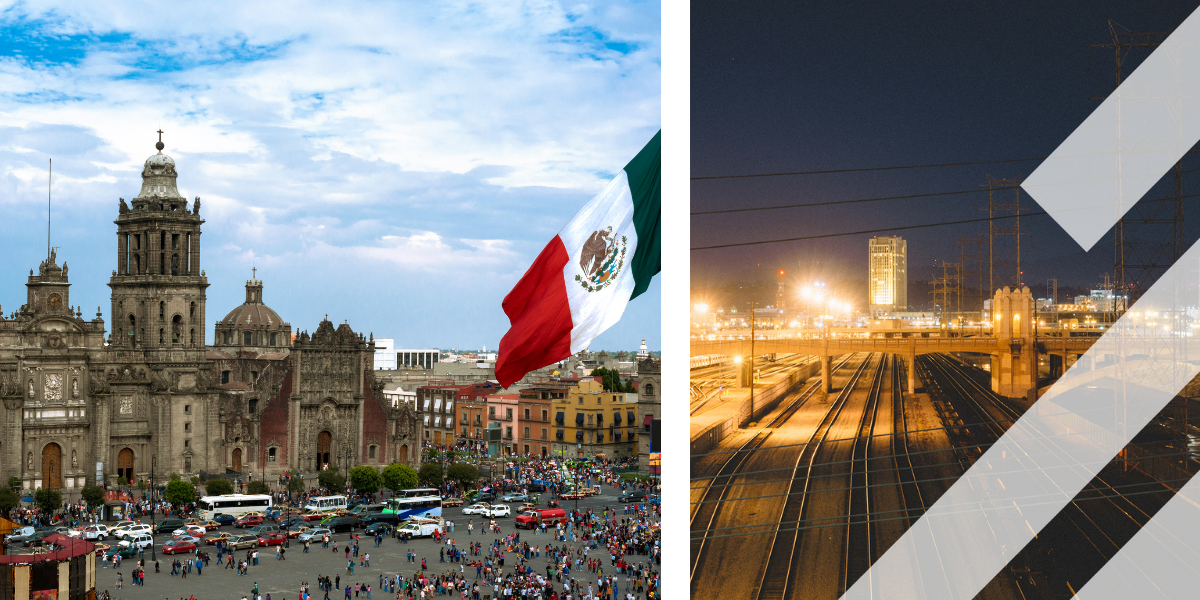Speeding up the mobility transition: Pieter Litjens, CROW
With the continuous growth of the population and ongoing urbanization, there are numerous mobility challenges. Sustainability, safety and societal impact are amongst our daily concerns. We need to speed up the mobility transition to keep up with the fast-changing global dynamics, which requires inventive approaches and better solutions. In this series, we share inspiring and innovative cases from all over the world. We spoke to Pieter Litjens, Director at CROW, knowledge institute for infrastructure, public space and mobility. How does he speed up the mobility transition?
Pieter Litjens has been in the mobility field for quite some years. As alderman of Traffic & Mobility in the city of Amsterdam he was responsible for the Noord-Zuidlijn, a subway project, decreased congestion and let good analysis and data play an important role in decision making. Over the years his biggest drive has become sustainable mobility. Today he is also chairman of the Stakeholder Committee for Mobility of the Dutch Climate agreement and we are happy he is head of the Intertraffic Award Jury.
‘To really challenge our biggest task of sustainable mobility, we have to make choices that might impact the freedom of mobility for people.’
‘If we all put some extra effort (and subsidies) in it, I am sure we are able to only sell electric vehicles by 2030. Then, we practically solved the CO2 problems when it comes to car mobility. However, since we are building more houses and the need for mobility is growing. In the Amsterdam metropolitan region alone 240,000 new houses will have to be built in the next years which will lead to a 20% increase of mobility. If this would all be emission free mobility, we do not have any problem. If we count 1,8 person per new house using same mobility as now, this will lead to an impossible and unliveable situation. Liveability should be our main subject. To really challenge our biggest task of sustainable mobility, we have to make choices that might impact the freedom of mobility for people.’
‘One example is a very busy intersection and connection in the city centre of Amsterdam, the Muntplein. Research showed that over two thirds of car traffic did not come from or go to that area. It was only through traffic, for instance from the north to the south side of the city, causing congestion. So we decided to close that connection for car traffic. Not to hassle the people, but with so little space, we had to make a choice and give cyclists and pedestrians priority over cars. People who go through can drive a different route or take the subway instead.’
‘I believe in city junctions and mobility hubs where shared mobility options are being offered.’
‘To me sustainability needs to be future proof. I believe in city junctions and mobility hubs where shared mobility options are being offered. A good example lies in the Amsterdam Zuidas, where a housing corporation calculated that it would not be necessary for every person to own a car, due to the good public transport connections. The corporation offers shared electric cars to motivate people to get rid of their own car. This only works in places with a good network and services. Outside the city this will be difficult.’

‘These successful examples show that change of behaviour does not come on itself. For example, the fact that people no longer drink and drive is partly thanks to a big national campaign in combination with enforcement. With freedom comes responsibility and if people do not take their own responsibility, I think the government should help people do so to the benefit of other people’s freedom.’
‘Mobility should no longer be seen as a goal, but as a way to achieve a liveable society.’
‘The role of mobility should also change. It should no longer be seen as a goal, but as a way to achieve a liveable society. We need to think about smarter modes of mobility that are safe, emission free and take up less space. I have high expectations for shared mobility in cities. Recent research showed the number of electric shared vehicles doubled between 2020 and 2021. Almost one million Dutch subscribed for a car-sharing service, however 80% hardly ever use it. Whereas some call it a failure, I would rather call it a lot of potential!’‘I would rather have my car dealer taking time to explain all the intelligent systems that can improve road safety than him making a nice picture of me and my new car.’
‘Data and technology also play a big role in speeding up the mobility transition. Take speed enforcement for example. Despite the enormous number of traffic signs, people do not follow up on the speed advices. Therefore, it would be wise to implement a system of intelligent speed adaptation (ISA). Test cases showed that when 30% of the traffic is provided with ISA, 80% of the drivers automatically apply the correct speed.’
‘These examples might be seen as patronizing, but it is a matter of habituation. We experienced the same with seatbelts and drink and drive. The same goes for lane-keeping or ISA. Information and education should play a bigger part in this. I would rather have my car dealer taking time to explain all the intelligent systems that can improve road safety than him making a nice picture of me before my new car…’
'My challenge is to make sure that mobility is involved in decision making from the start of the project.’
‘Another thing that needs to change in the Netherlands is the role of mobility in urban planning. Often mobility is included in the final phase of the project. My challenge is to make sure that mobility is involved in decision making from the start of the project. Building traffic infrastructure takes so much time in our country. For public transport sometimes even 10-20 years. Often the neighbourhoods are built very fast and high quality mobility solutions lacks behind. The consequence is that, while people are waiting for high quality public transport, green areas are often changed back into parking spaces.’
‘In public transport we should also learn to decide based on facts and research instead of status or gut feeling. Very often bus rapid transit systems are seen as a forerunner of railway mobility systems. Now, 100-150 years ago the train was quite an innovative mobility concept compared to the often terrible road infrastructure. Nowadays, bus trans rapid systems accommodate almost as many passengers as railway systems, against much lower cost and with more flexibility.’
‘If we need 100 million batteries per year worldwide, we also need to think about next steps to avoid a commodity crisis.’
‘When it comes to modalities and climate goals, I think we should focus on electric driving and less on hydrogen. The conversion loss can be 40%, which is an inefficient way of using the scarce sustainable energy, especially when there’s a good alternative. Then again, we have to think future proof. If we need 100 million batteries per year worldwide, we also need to think about next steps or technologies to avoid a commodity crisis. Think of the limited amount of cobalt, essential in the production of batteries. Another big challenge is providing a good charging infrastructure for electric driving. The Netherlands has been leading the way in the last few years, but significant steps yet have to be made in order to reach our the climate goals.’
‘What gives me most energy at CROW is that we connect organisations, developments and innovations with each other. In the project CIVITAS Handshake European cities help each other by learning from other experiences and implementations. The city of Helsinki is figuring out how to become a bicycle city. Yet it faces several challenges, like a poor cycling infrastructure, severe winters and the fact that cycling is not (yet) considered a daily activity. Together with Amsterdam and Copenhagen we exchanged our knowledge, to help other cities improve their mobility systems, as well as to learn from their experiences. I am happy to see the CROW Bicycle Design Manual on how to design a cycle friendly infrastructure was used a lot. Our knowledge and that of a lot of innovative Dutch companies, can help other places in the world to create liveable cities. It’s great to contribute to those developments and to have societal impact.’
‘It’s great to have societal impact, also very important in this years’ Intertraffic Awards.’
‘Societal impact is also very important in this years’ Intertraffic Awards. It means direct impact on road safety or direct impact on emissions for instance. It does not necessarily have to be a proven concept, but it should be scalable and obviously be put in practise. I look forward to reviewing the submitted innovations!’
More on sustainable mobility, infrastructure and Intertraffic awards:
Share your story
Do you have an innovation, research results or an other interesting topic you would like to share with the professionals in the infrastructure, traffic management, safety, smart mobility and parking industry? The Intertraffic website and social media channels are a great platform to showcase your stories!
Please contact our Sr Brand Marketing Manager Carola Jansen-Young.
Are you an Intertraffic exhibitor?
Make sure you add your latest press releases to your Company Profile in the Exhibitor Portal for free exposure.
Get up to speed on the mobility industry - our newsletter straight to your inbox!









